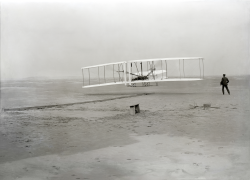Transatlantic Flight

Since the ancient Greek legend of Daedalus and his son Icarus, we have been obsessed with learning how to fly like the birds.
With wings made of wax and feathers, Daedalus escaped imprisonment by King Minos, flying successfully from Crete to Naples. But Icarus tried to fly too high and flew too near the sun. The wings of wax melted, and Icarus fell to his death in the ocean.
In the 1480s, Leonardo da Vinci made the first real studies of flight, and had over one hundred drawings which illustrated his theories. One of these was the Ornithopter. Although it was never actually created, the modern day helicopter is based on this concept.
Otto Lilienthal was the first person to design a glider which could fly a person and was able to fly long distances. He was fascinated by the idea of flight, and based on his studies, he wrote a book on aerodynamics which was published in 1889.
Orville and Wilbur Wright, better known as The Wright Brothers, used this text in their own quest for flight. After perfecting a glider shape, they designed an engine which would create the thrust needed to fly.
They called their airplane the 'Flyer' and it flew for the first time on December 17th 1903, traveling one hundred twenty feet in twelve seconds. Evidently more work was needed, and the two brothers worked tirelessly to perfect their design. Finally, on October 5th 1905, Wilbur piloted the 'Flyer III', circling around the Huffman Prairie for 39 minutes, until he ran out of gas.
Over the past 115 years, there have been many new airplanes and engines developed, and with that came the daredevil pilots who wanted to break records!
In 1913, The Daily Mail newspaper in London, England, offered a prize of £10,000 to "the aviator who shall first cross the Atlantic in an aeroplane in flight from any point in the United States of America, Canada or Newfoundland and any point in Great Britain or Ireland" in 72 continuous hours."
The competition stalled with the outbreak of war, but once the Armistice was declared in 1918 it began to hot up again with four teams competing to be the first non-stop across the Atlantic. One of these was John Alcock and Arthur Whitten Brown. You can listen to their story in the old time radio broadcast from Scoop, a South African series.
There are also several radio shows about early flight, including the 'true' story of the Wright Brothers, told as comically as ever by Jack Benny on the Fred Allen Show, and also in the series Little Orphan Annie on the 33rd anniversary.
Other early stories of flight include Flight to Nowhere from the series Inheritance. Way of an Eagle from the series Adventures in Research, and from The Magic Key, a 10th anniversary celebration of Charles Lindbergh's solo transatlantic flight to Paris on May 20-21, 1927.
Happy listening my friends,
